Paul Rand's Influence on Design: Histories and Future Perspectives
VerifiedAdded on 2023/06/05
|9
|2077
|218
Essay
AI Summary
This essay delves into the life and work of Paul Rand, a highly influential graphic designer who revolutionized the field and elevated graphic design to a respected art form. It discusses his early influences, his studies at Pratt Institute and Parsons School of Design, and his work for renowned clients such as ABC, UPS, and Westinghouse. The essay highlights Rand's ability to blend elements from Bauhaus, de Stijl, and Constructivism, as well as his innovative approach to logo design and corporate branding. Examples of his notable designs, including advertisements for Jacqueline Cochran cosmetics and the children's book cover for "I Know a Lot of Things," are analyzed to showcase his unique style. The essay further emphasizes Rand's contribution to modernizing American advertising and his role in shaping the public identity of corporations through his designs. It also examines his design philosophy, which prioritized creating memorable and visually stimulating designs that effectively communicated a brand's identity. The essay concludes by asserting that Paul Rand's legacy continues to inspire modern graphic designers and that his unconventional approach to design has left an indelible mark on the field.
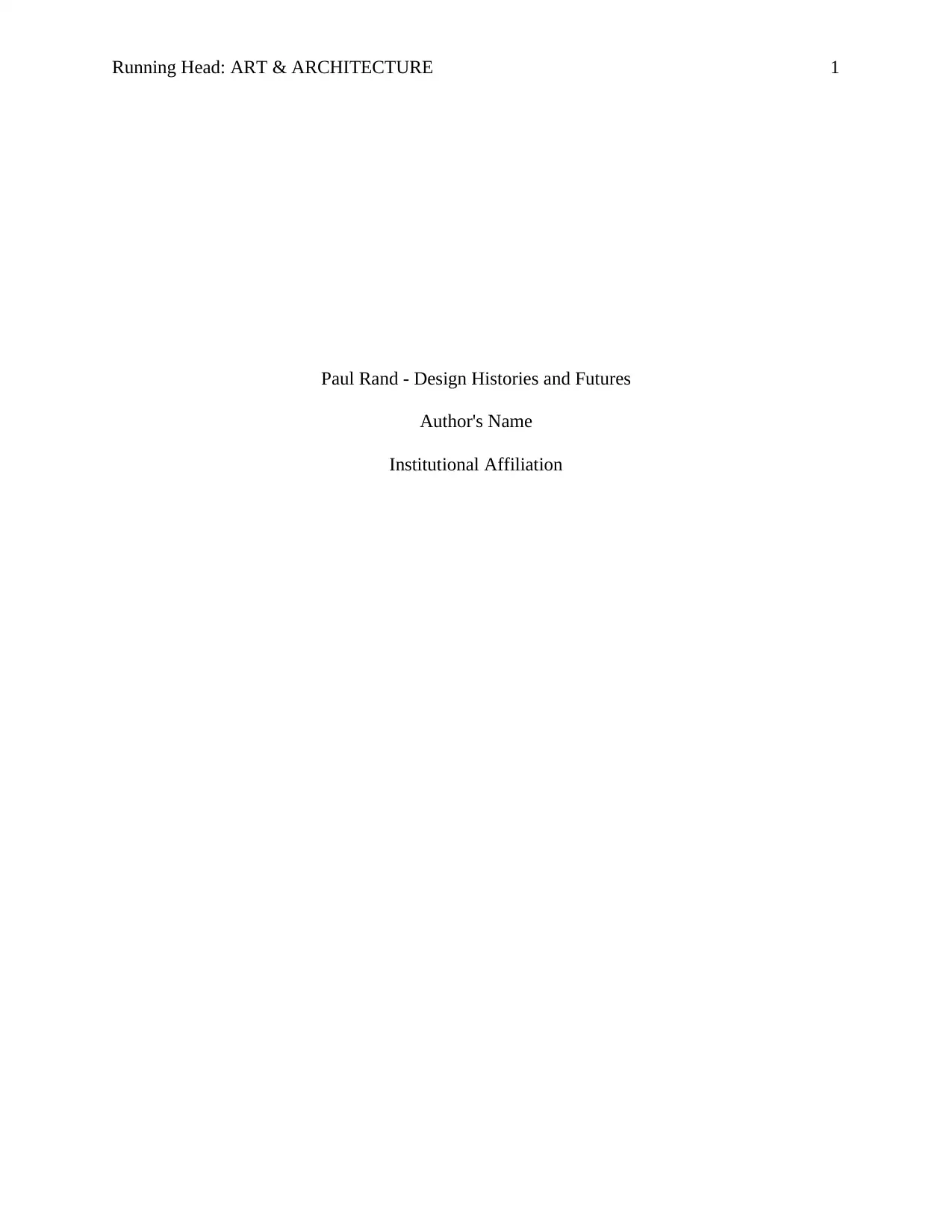
Running Head: ART & ARCHITECTURE 1
Paul Rand - Design Histories and Futures
Author's Name
Institutional Affiliation
Paul Rand - Design Histories and Futures
Author's Name
Institutional Affiliation
Paraphrase This Document
Need a fresh take? Get an instant paraphrase of this document with our AI Paraphraser
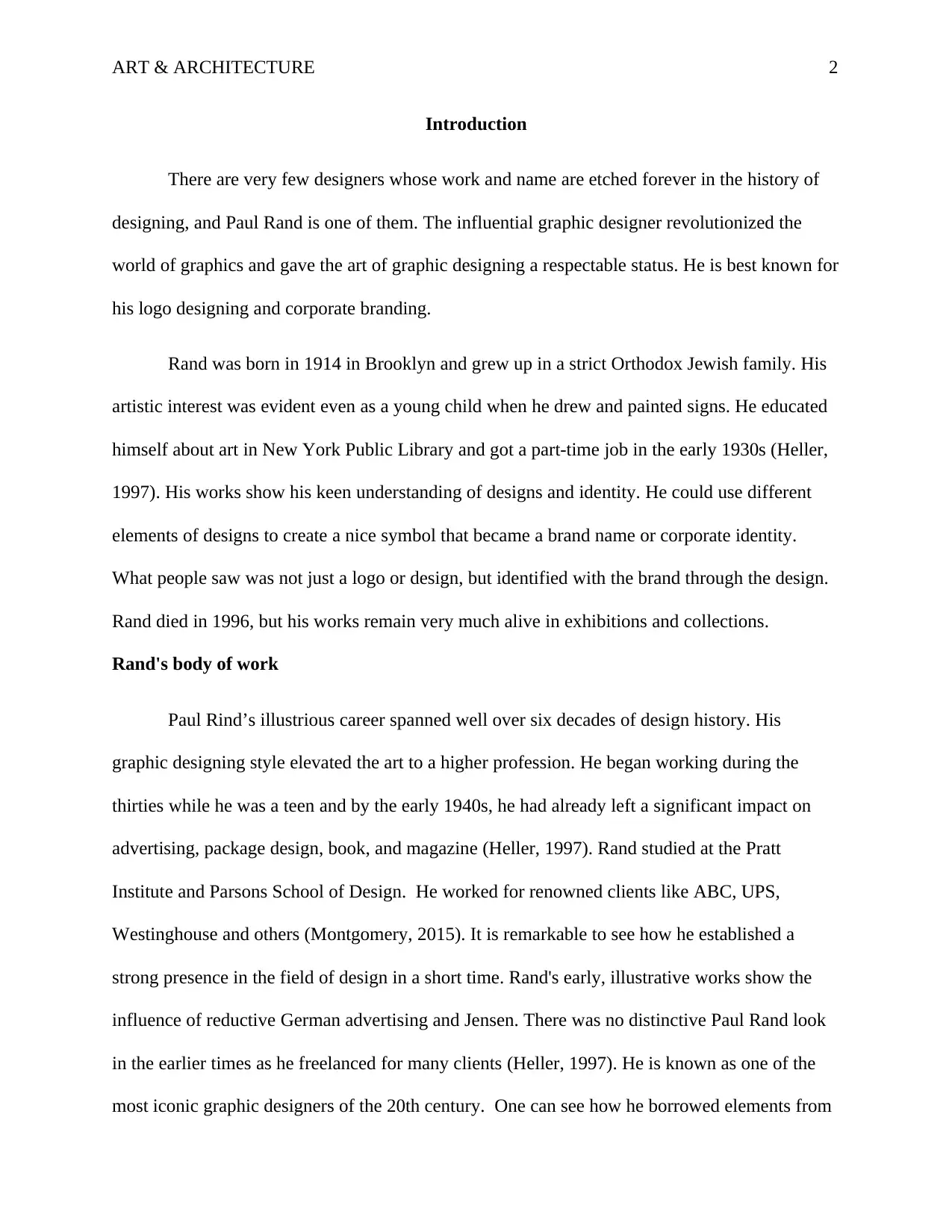
ART & ARCHITECTURE 2
Introduction
There are very few designers whose work and name are etched forever in the history of
designing, and Paul Rand is one of them. The influential graphic designer revolutionized the
world of graphics and gave the art of graphic designing a respectable status. He is best known for
his logo designing and corporate branding.
Rand was born in 1914 in Brooklyn and grew up in a strict Orthodox Jewish family. His
artistic interest was evident even as a young child when he drew and painted signs. He educated
himself about art in New York Public Library and got a part-time job in the early 1930s (Heller,
1997). His works show his keen understanding of designs and identity. He could use different
elements of designs to create a nice symbol that became a brand name or corporate identity.
What people saw was not just a logo or design, but identified with the brand through the design.
Rand died in 1996, but his works remain very much alive in exhibitions and collections.
Rand's body of work
Paul Rind’s illustrious career spanned well over six decades of design history. His
graphic designing style elevated the art to a higher profession. He began working during the
thirties while he was a teen and by the early 1940s, he had already left a significant impact on
advertising, package design, book, and magazine (Heller, 1997). Rand studied at the Pratt
Institute and Parsons School of Design. He worked for renowned clients like ABC, UPS,
Westinghouse and others (Montgomery, 2015). It is remarkable to see how he established a
strong presence in the field of design in a short time. Rand's early, illustrative works show the
influence of reductive German advertising and Jensen. There was no distinctive Paul Rand look
in the earlier times as he freelanced for many clients (Heller, 1997). He is known as one of the
most iconic graphic designers of the 20th century. One can see how he borrowed elements from
Introduction
There are very few designers whose work and name are etched forever in the history of
designing, and Paul Rand is one of them. The influential graphic designer revolutionized the
world of graphics and gave the art of graphic designing a respectable status. He is best known for
his logo designing and corporate branding.
Rand was born in 1914 in Brooklyn and grew up in a strict Orthodox Jewish family. His
artistic interest was evident even as a young child when he drew and painted signs. He educated
himself about art in New York Public Library and got a part-time job in the early 1930s (Heller,
1997). His works show his keen understanding of designs and identity. He could use different
elements of designs to create a nice symbol that became a brand name or corporate identity.
What people saw was not just a logo or design, but identified with the brand through the design.
Rand died in 1996, but his works remain very much alive in exhibitions and collections.
Rand's body of work
Paul Rind’s illustrious career spanned well over six decades of design history. His
graphic designing style elevated the art to a higher profession. He began working during the
thirties while he was a teen and by the early 1940s, he had already left a significant impact on
advertising, package design, book, and magazine (Heller, 1997). Rand studied at the Pratt
Institute and Parsons School of Design. He worked for renowned clients like ABC, UPS,
Westinghouse and others (Montgomery, 2015). It is remarkable to see how he established a
strong presence in the field of design in a short time. Rand's early, illustrative works show the
influence of reductive German advertising and Jensen. There was no distinctive Paul Rand look
in the earlier times as he freelanced for many clients (Heller, 1997). He is known as one of the
most iconic graphic designers of the 20th century. One can see how he borrowed elements from
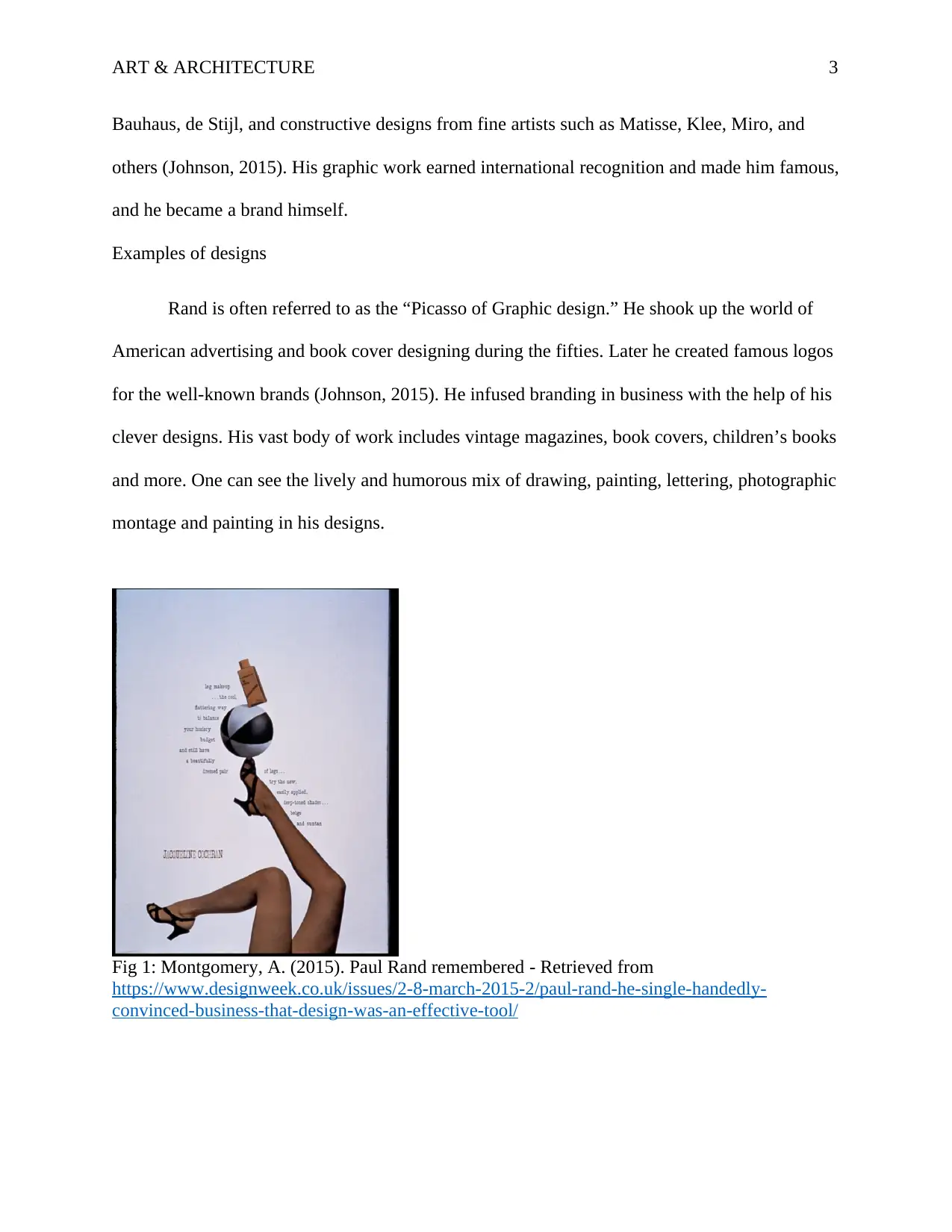
ART & ARCHITECTURE 3
Bauhaus, de Stijl, and constructive designs from fine artists such as Matisse, Klee, Miro, and
others (Johnson, 2015). His graphic work earned international recognition and made him famous,
and he became a brand himself.
Examples of designs
Rand is often referred to as the “Picasso of Graphic design.” He shook up the world of
American advertising and book cover designing during the fifties. Later he created famous logos
for the well-known brands (Johnson, 2015). He infused branding in business with the help of his
clever designs. His vast body of work includes vintage magazines, book covers, children’s books
and more. One can see the lively and humorous mix of drawing, painting, lettering, photographic
montage and painting in his designs.
Fig 1: Montgomery, A. (2015). Paul Rand remembered - Retrieved from
https://www.designweek.co.uk/issues/2-8-march-2015-2/paul-rand-he-single-handedly-
convinced-business-that-design-was-an-effective-tool/
Bauhaus, de Stijl, and constructive designs from fine artists such as Matisse, Klee, Miro, and
others (Johnson, 2015). His graphic work earned international recognition and made him famous,
and he became a brand himself.
Examples of designs
Rand is often referred to as the “Picasso of Graphic design.” He shook up the world of
American advertising and book cover designing during the fifties. Later he created famous logos
for the well-known brands (Johnson, 2015). He infused branding in business with the help of his
clever designs. His vast body of work includes vintage magazines, book covers, children’s books
and more. One can see the lively and humorous mix of drawing, painting, lettering, photographic
montage and painting in his designs.
Fig 1: Montgomery, A. (2015). Paul Rand remembered - Retrieved from
https://www.designweek.co.uk/issues/2-8-march-2015-2/paul-rand-he-single-handedly-
convinced-business-that-design-was-an-effective-tool/
⊘ This is a preview!⊘
Do you want full access?
Subscribe today to unlock all pages.

Trusted by 1+ million students worldwide
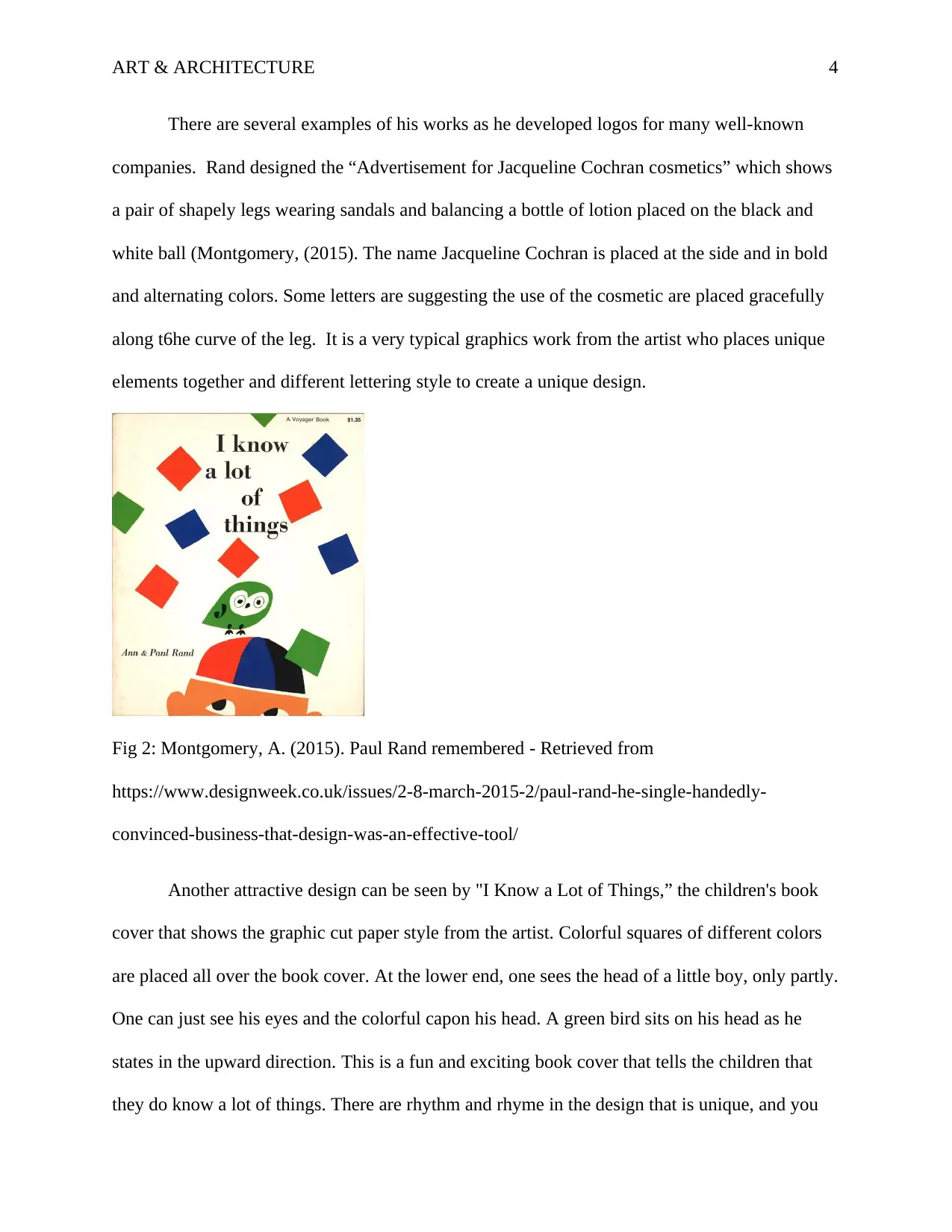
ART & ARCHITECTURE 4
There are several examples of his works as he developed logos for many well-known
companies. Rand designed the “Advertisement for Jacqueline Cochran cosmetics” which shows
a pair of shapely legs wearing sandals and balancing a bottle of lotion placed on the black and
white ball (Montgomery, (2015). The name Jacqueline Cochran is placed at the side and in bold
and alternating colors. Some letters are suggesting the use of the cosmetic are placed gracefully
along t6he curve of the leg. It is a very typical graphics work from the artist who places unique
elements together and different lettering style to create a unique design.
Fig 2: Montgomery, A. (2015). Paul Rand remembered - Retrieved from
https://www.designweek.co.uk/issues/2-8-march-2015-2/paul-rand-he-single-handedly-
convinced-business-that-design-was-an-effective-tool/
Another attractive design can be seen by "I Know a Lot of Things,” the children's book
cover that shows the graphic cut paper style from the artist. Colorful squares of different colors
are placed all over the book cover. At the lower end, one sees the head of a little boy, only partly.
One can just see his eyes and the colorful capon his head. A green bird sits on his head as he
states in the upward direction. This is a fun and exciting book cover that tells the children that
they do know a lot of things. There are rhythm and rhyme in the design that is unique, and you
There are several examples of his works as he developed logos for many well-known
companies. Rand designed the “Advertisement for Jacqueline Cochran cosmetics” which shows
a pair of shapely legs wearing sandals and balancing a bottle of lotion placed on the black and
white ball (Montgomery, (2015). The name Jacqueline Cochran is placed at the side and in bold
and alternating colors. Some letters are suggesting the use of the cosmetic are placed gracefully
along t6he curve of the leg. It is a very typical graphics work from the artist who places unique
elements together and different lettering style to create a unique design.
Fig 2: Montgomery, A. (2015). Paul Rand remembered - Retrieved from
https://www.designweek.co.uk/issues/2-8-march-2015-2/paul-rand-he-single-handedly-
convinced-business-that-design-was-an-effective-tool/
Another attractive design can be seen by "I Know a Lot of Things,” the children's book
cover that shows the graphic cut paper style from the artist. Colorful squares of different colors
are placed all over the book cover. At the lower end, one sees the head of a little boy, only partly.
One can just see his eyes and the colorful capon his head. A green bird sits on his head as he
states in the upward direction. This is a fun and exciting book cover that tells the children that
they do know a lot of things. There are rhythm and rhyme in the design that is unique, and you
Paraphrase This Document
Need a fresh take? Get an instant paraphrase of this document with our AI Paraphraser
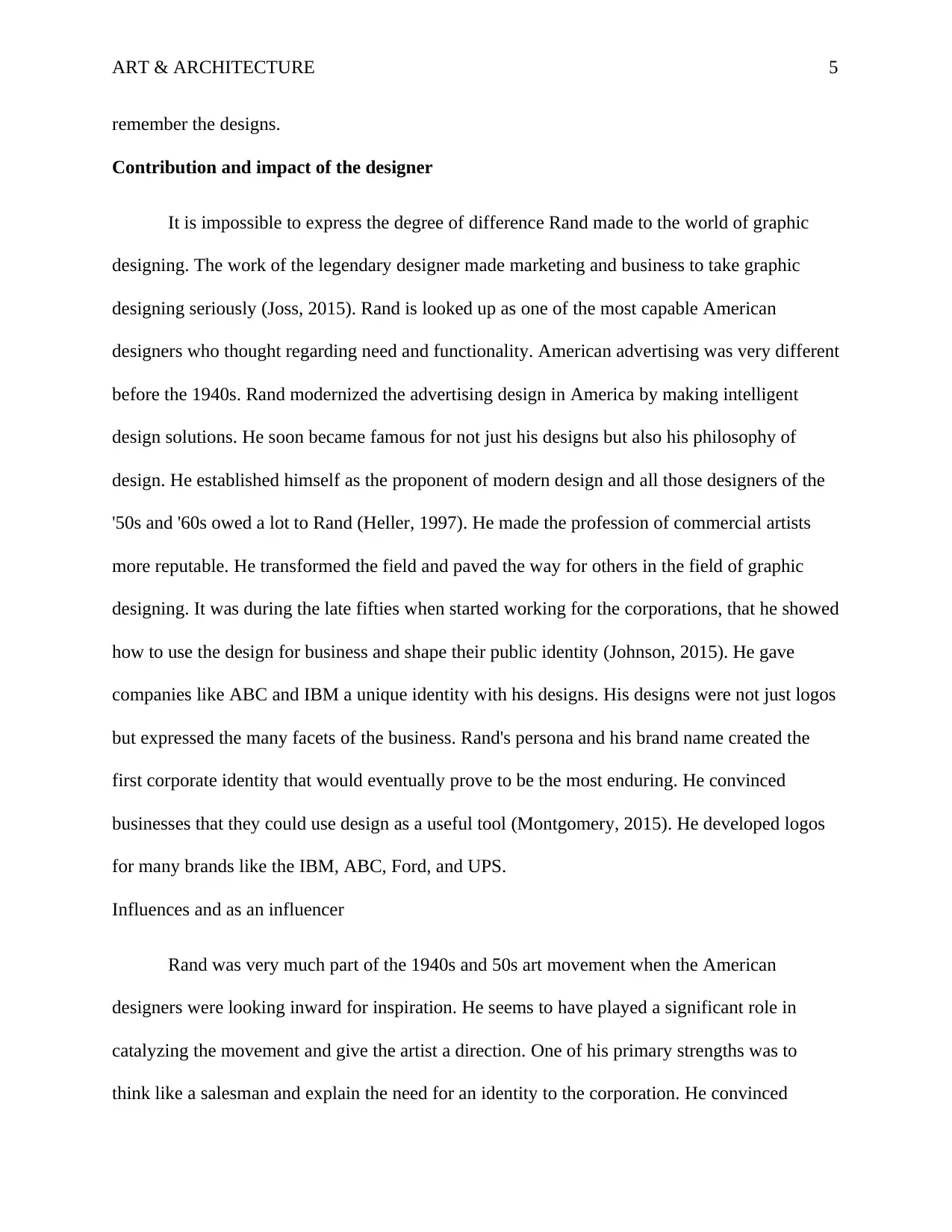
ART & ARCHITECTURE 5
remember the designs.
Contribution and impact of the designer
It is impossible to express the degree of difference Rand made to the world of graphic
designing. The work of the legendary designer made marketing and business to take graphic
designing seriously (Joss, 2015). Rand is looked up as one of the most capable American
designers who thought regarding need and functionality. American advertising was very different
before the 1940s. Rand modernized the advertising design in America by making intelligent
design solutions. He soon became famous for not just his designs but also his philosophy of
design. He established himself as the proponent of modern design and all those designers of the
'50s and '60s owed a lot to Rand (Heller, 1997). He made the profession of commercial artists
more reputable. He transformed the field and paved the way for others in the field of graphic
designing. It was during the late fifties when started working for the corporations, that he showed
how to use the design for business and shape their public identity (Johnson, 2015). He gave
companies like ABC and IBM a unique identity with his designs. His designs were not just logos
but expressed the many facets of the business. Rand's persona and his brand name created the
first corporate identity that would eventually prove to be the most enduring. He convinced
businesses that they could use design as a useful tool (Montgomery, 2015). He developed logos
for many brands like the IBM, ABC, Ford, and UPS.
Influences and as an influencer
Rand was very much part of the 1940s and 50s art movement when the American
designers were looking inward for inspiration. He seems to have played a significant role in
catalyzing the movement and give the artist a direction. One of his primary strengths was to
think like a salesman and explain the need for an identity to the corporation. He convinced
remember the designs.
Contribution and impact of the designer
It is impossible to express the degree of difference Rand made to the world of graphic
designing. The work of the legendary designer made marketing and business to take graphic
designing seriously (Joss, 2015). Rand is looked up as one of the most capable American
designers who thought regarding need and functionality. American advertising was very different
before the 1940s. Rand modernized the advertising design in America by making intelligent
design solutions. He soon became famous for not just his designs but also his philosophy of
design. He established himself as the proponent of modern design and all those designers of the
'50s and '60s owed a lot to Rand (Heller, 1997). He made the profession of commercial artists
more reputable. He transformed the field and paved the way for others in the field of graphic
designing. It was during the late fifties when started working for the corporations, that he showed
how to use the design for business and shape their public identity (Johnson, 2015). He gave
companies like ABC and IBM a unique identity with his designs. His designs were not just logos
but expressed the many facets of the business. Rand's persona and his brand name created the
first corporate identity that would eventually prove to be the most enduring. He convinced
businesses that they could use design as a useful tool (Montgomery, 2015). He developed logos
for many brands like the IBM, ABC, Ford, and UPS.
Influences and as an influencer
Rand was very much part of the 1940s and 50s art movement when the American
designers were looking inward for inspiration. He seems to have played a significant role in
catalyzing the movement and give the artist a direction. One of his primary strengths was to
think like a salesman and explain the need for an identity to the corporation. He convinced
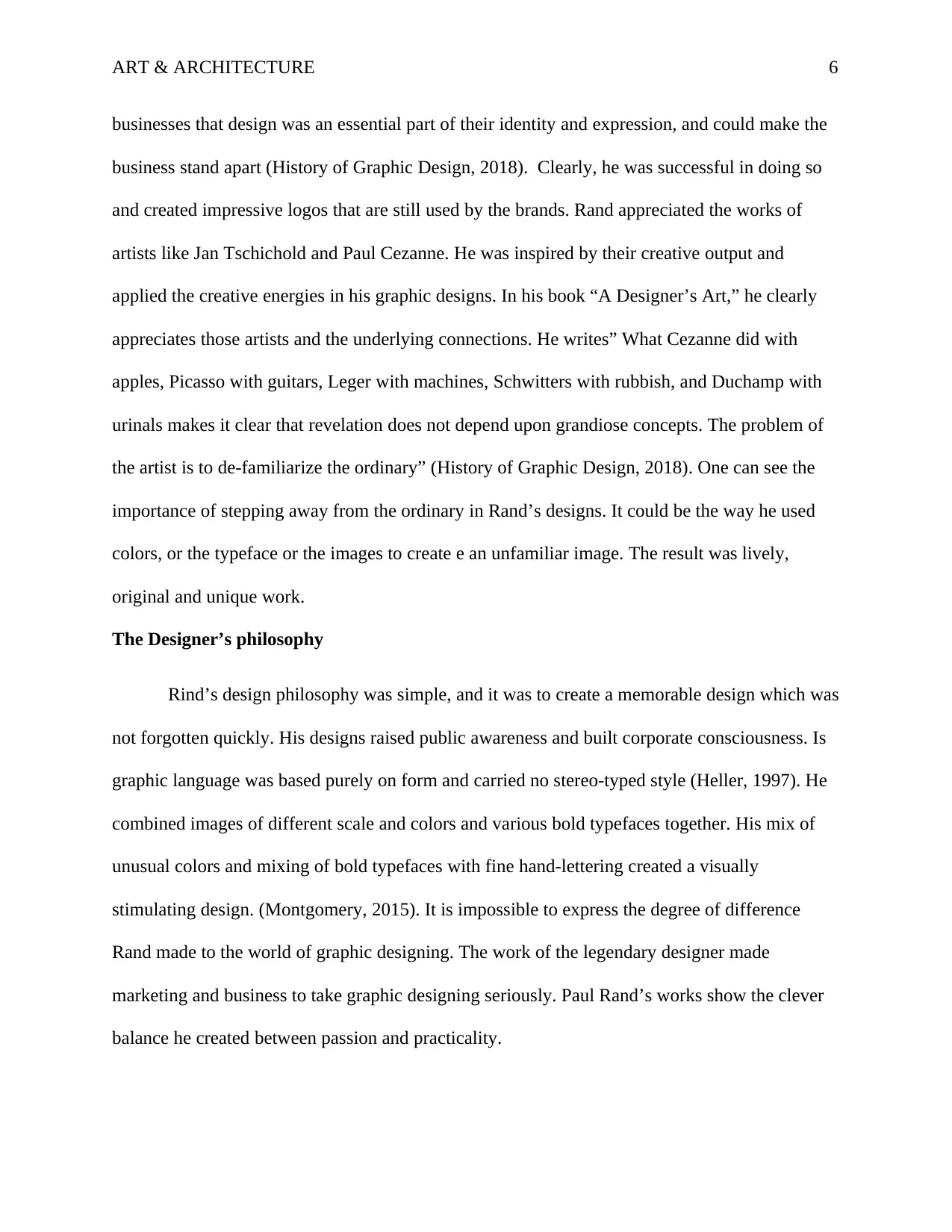
ART & ARCHITECTURE 6
businesses that design was an essential part of their identity and expression, and could make the
business stand apart (History of Graphic Design, 2018). Clearly, he was successful in doing so
and created impressive logos that are still used by the brands. Rand appreciated the works of
artists like Jan Tschichold and Paul Cezanne. He was inspired by their creative output and
applied the creative energies in his graphic designs. In his book “A Designer’s Art,” he clearly
appreciates those artists and the underlying connections. He writes” What Cezanne did with
apples, Picasso with guitars, Leger with machines, Schwitters with rubbish, and Duchamp with
urinals makes it clear that revelation does not depend upon grandiose concepts. The problem of
the artist is to de-familiarize the ordinary” (History of Graphic Design, 2018). One can see the
importance of stepping away from the ordinary in Rand’s designs. It could be the way he used
colors, or the typeface or the images to create e an unfamiliar image. The result was lively,
original and unique work.
The Designer’s philosophy
Rind’s design philosophy was simple, and it was to create a memorable design which was
not forgotten quickly. His designs raised public awareness and built corporate consciousness. Is
graphic language was based purely on form and carried no stereo-typed style (Heller, 1997). He
combined images of different scale and colors and various bold typefaces together. His mix of
unusual colors and mixing of bold typefaces with fine hand-lettering created a visually
stimulating design. (Montgomery, 2015). It is impossible to express the degree of difference
Rand made to the world of graphic designing. The work of the legendary designer made
marketing and business to take graphic designing seriously. Paul Rand’s works show the clever
balance he created between passion and practicality.
businesses that design was an essential part of their identity and expression, and could make the
business stand apart (History of Graphic Design, 2018). Clearly, he was successful in doing so
and created impressive logos that are still used by the brands. Rand appreciated the works of
artists like Jan Tschichold and Paul Cezanne. He was inspired by their creative output and
applied the creative energies in his graphic designs. In his book “A Designer’s Art,” he clearly
appreciates those artists and the underlying connections. He writes” What Cezanne did with
apples, Picasso with guitars, Leger with machines, Schwitters with rubbish, and Duchamp with
urinals makes it clear that revelation does not depend upon grandiose concepts. The problem of
the artist is to de-familiarize the ordinary” (History of Graphic Design, 2018). One can see the
importance of stepping away from the ordinary in Rand’s designs. It could be the way he used
colors, or the typeface or the images to create e an unfamiliar image. The result was lively,
original and unique work.
The Designer’s philosophy
Rind’s design philosophy was simple, and it was to create a memorable design which was
not forgotten quickly. His designs raised public awareness and built corporate consciousness. Is
graphic language was based purely on form and carried no stereo-typed style (Heller, 1997). He
combined images of different scale and colors and various bold typefaces together. His mix of
unusual colors and mixing of bold typefaces with fine hand-lettering created a visually
stimulating design. (Montgomery, 2015). It is impossible to express the degree of difference
Rand made to the world of graphic designing. The work of the legendary designer made
marketing and business to take graphic designing seriously. Paul Rand’s works show the clever
balance he created between passion and practicality.
⊘ This is a preview!⊘
Do you want full access?
Subscribe today to unlock all pages.

Trusted by 1+ million students worldwide
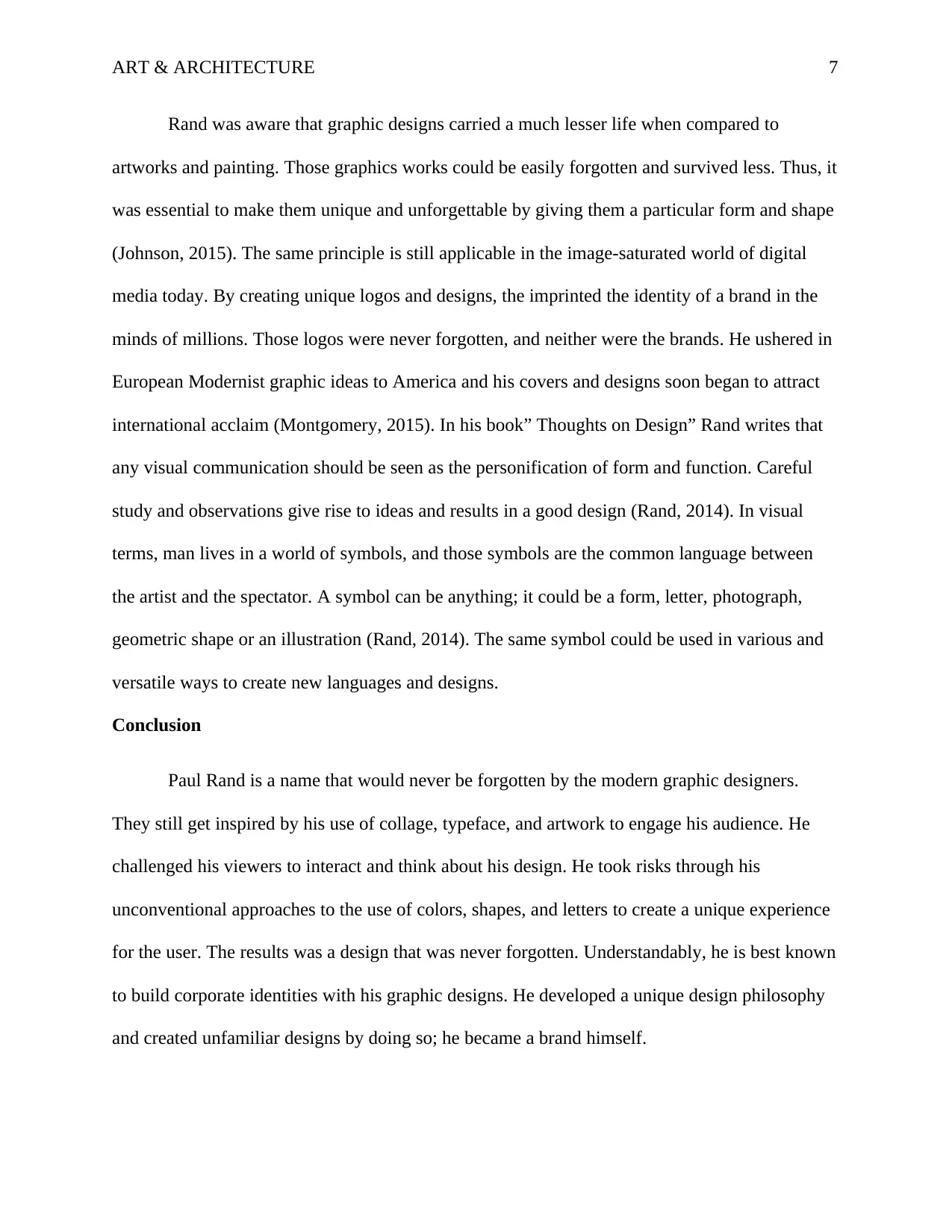
ART & ARCHITECTURE 7
Rand was aware that graphic designs carried a much lesser life when compared to
artworks and painting. Those graphics works could be easily forgotten and survived less. Thus, it
was essential to make them unique and unforgettable by giving them a particular form and shape
(Johnson, 2015). The same principle is still applicable in the image-saturated world of digital
media today. By creating unique logos and designs, the imprinted the identity of a brand in the
minds of millions. Those logos were never forgotten, and neither were the brands. He ushered in
European Modernist graphic ideas to America and his covers and designs soon began to attract
international acclaim (Montgomery, 2015). In his book” Thoughts on Design” Rand writes that
any visual communication should be seen as the personification of form and function. Careful
study and observations give rise to ideas and results in a good design (Rand, 2014). In visual
terms, man lives in a world of symbols, and those symbols are the common language between
the artist and the spectator. A symbol can be anything; it could be a form, letter, photograph,
geometric shape or an illustration (Rand, 2014). The same symbol could be used in various and
versatile ways to create new languages and designs.
Conclusion
Paul Rand is a name that would never be forgotten by the modern graphic designers.
They still get inspired by his use of collage, typeface, and artwork to engage his audience. He
challenged his viewers to interact and think about his design. He took risks through his
unconventional approaches to the use of colors, shapes, and letters to create a unique experience
for the user. The results was a design that was never forgotten. Understandably, he is best known
to build corporate identities with his graphic designs. He developed a unique design philosophy
and created unfamiliar designs by doing so; he became a brand himself.
Rand was aware that graphic designs carried a much lesser life when compared to
artworks and painting. Those graphics works could be easily forgotten and survived less. Thus, it
was essential to make them unique and unforgettable by giving them a particular form and shape
(Johnson, 2015). The same principle is still applicable in the image-saturated world of digital
media today. By creating unique logos and designs, the imprinted the identity of a brand in the
minds of millions. Those logos were never forgotten, and neither were the brands. He ushered in
European Modernist graphic ideas to America and his covers and designs soon began to attract
international acclaim (Montgomery, 2015). In his book” Thoughts on Design” Rand writes that
any visual communication should be seen as the personification of form and function. Careful
study and observations give rise to ideas and results in a good design (Rand, 2014). In visual
terms, man lives in a world of symbols, and those symbols are the common language between
the artist and the spectator. A symbol can be anything; it could be a form, letter, photograph,
geometric shape or an illustration (Rand, 2014). The same symbol could be used in various and
versatile ways to create new languages and designs.
Conclusion
Paul Rand is a name that would never be forgotten by the modern graphic designers.
They still get inspired by his use of collage, typeface, and artwork to engage his audience. He
challenged his viewers to interact and think about his design. He took risks through his
unconventional approaches to the use of colors, shapes, and letters to create a unique experience
for the user. The results was a design that was never forgotten. Understandably, he is best known
to build corporate identities with his graphic designs. He developed a unique design philosophy
and created unfamiliar designs by doing so; he became a brand himself.
Paraphrase This Document
Need a fresh take? Get an instant paraphrase of this document with our AI Paraphraser
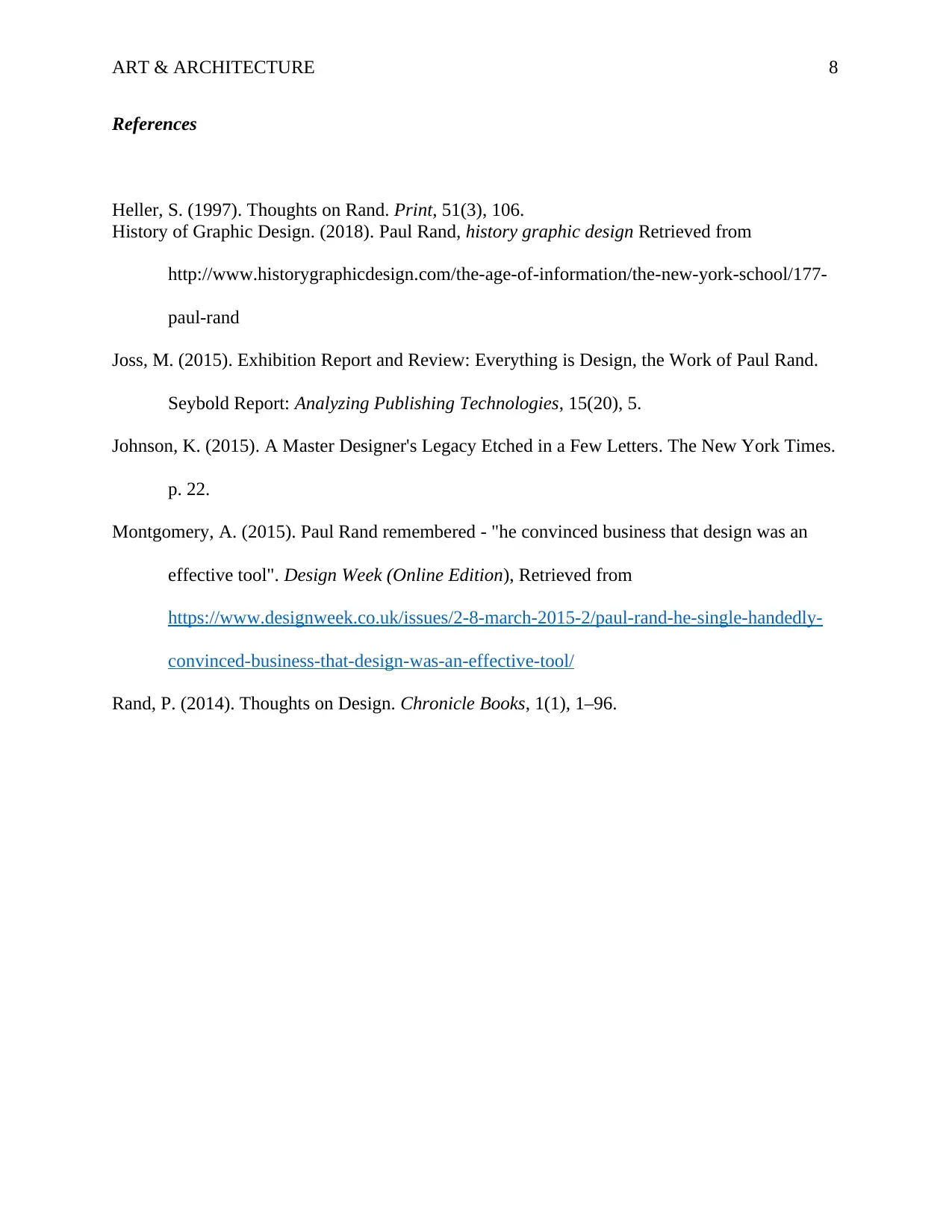
ART & ARCHITECTURE 8
References
Heller, S. (1997). Thoughts on Rand. Print, 51(3), 106.
History of Graphic Design. (2018). Paul Rand, history graphic design Retrieved from
http://www.historygraphicdesign.com/the-age-of-information/the-new-york-school/177-
paul-rand
Joss, M. (2015). Exhibition Report and Review: Everything is Design, the Work of Paul Rand.
Seybold Report: Analyzing Publishing Technologies, 15(20), 5.
Johnson, K. (2015). A Master Designer's Legacy Etched in a Few Letters. The New York Times.
p. 22.
Montgomery, A. (2015). Paul Rand remembered - "he convinced business that design was an
effective tool". Design Week (Online Edition), Retrieved from
https://www.designweek.co.uk/issues/2-8-march-2015-2/paul-rand-he-single-handedly-
convinced-business-that-design-was-an-effective-tool/
Rand, P. (2014). Thoughts on Design. Chronicle Books, 1(1), 1–96.
References
Heller, S. (1997). Thoughts on Rand. Print, 51(3), 106.
History of Graphic Design. (2018). Paul Rand, history graphic design Retrieved from
http://www.historygraphicdesign.com/the-age-of-information/the-new-york-school/177-
paul-rand
Joss, M. (2015). Exhibition Report and Review: Everything is Design, the Work of Paul Rand.
Seybold Report: Analyzing Publishing Technologies, 15(20), 5.
Johnson, K. (2015). A Master Designer's Legacy Etched in a Few Letters. The New York Times.
p. 22.
Montgomery, A. (2015). Paul Rand remembered - "he convinced business that design was an
effective tool". Design Week (Online Edition), Retrieved from
https://www.designweek.co.uk/issues/2-8-march-2015-2/paul-rand-he-single-handedly-
convinced-business-that-design-was-an-effective-tool/
Rand, P. (2014). Thoughts on Design. Chronicle Books, 1(1), 1–96.

ART & ARCHITECTURE 9
⊘ This is a preview!⊘
Do you want full access?
Subscribe today to unlock all pages.

Trusted by 1+ million students worldwide
1 out of 9
Your All-in-One AI-Powered Toolkit for Academic Success.
+13062052269
info@desklib.com
Available 24*7 on WhatsApp / Email
![[object Object]](/_next/static/media/star-bottom.7253800d.svg)
Unlock your academic potential
Copyright © 2020–2025 A2Z Services. All Rights Reserved. Developed and managed by ZUCOL.